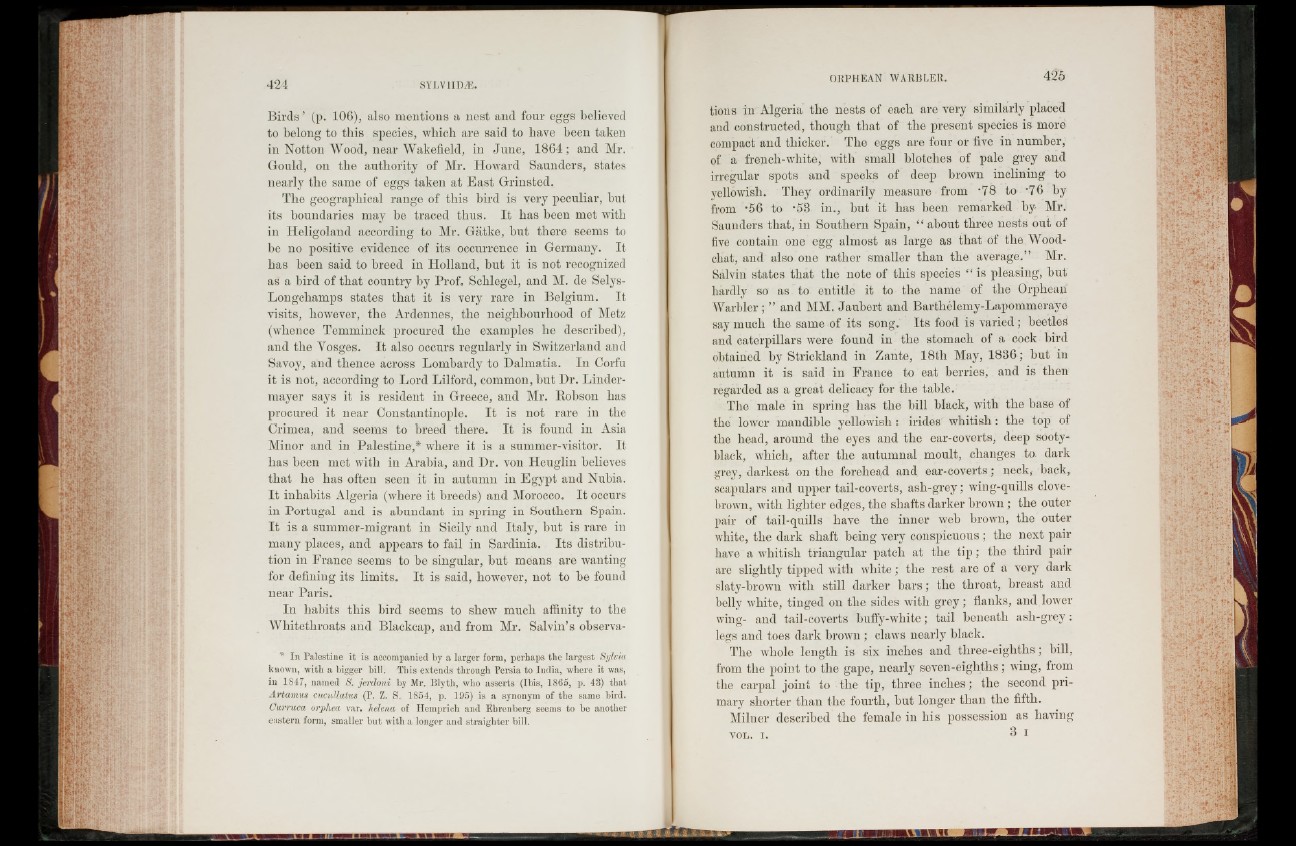
Birds ’ (p. 106), also mentions a nest and four eggs believed
to belong to this species, which are said to have been taken
in Notton Wood, near Wakefield, in June, 1864; and Mr.
Gould, on the authority of Mr. Howard Saunders, states
nearly the same of eggs taken at East Grinsted.
The geographical range of this bird is very peculiar, but
its boundaries may be traced thus. I t has been met with
in Heligoland according to Mr. Gatke, but there seems to
be no positive evidence of its occurrence in Germany. It
has been said to breed in Holland, but it is not recognized
as a bird of that country by Prof. Sclilegel, and M. de Selys-
Lougeliamps states that it is very rare in Belgium. It
visits, however, the Ardennes, the neighbourhood of Metz
(whence Temminck procured the examples he described),
and the Yosges. I t also occurs regularly in Switzerland and
Savoy, and thence across Lombardy to Dalmatia. In Corfu
it is not, according to Lord Lilford, common, but Dr. Linder-
mayer says it is resident in Greece, and Mr. Robson has
procured it near Constantinople. I t is not rare in the
Crimea, and seems to breed there. I t is found in Asia
Minor and in Palestine,* where it is a summer-visitor. It
has been met with in Arabia, and Dr. von Heuglin believes
that he has often seen it in autumn in Egypt and Nubia.
I t inhabits Algeria (where it breeds) and Morocco. I t occurs
in Portugal and is abundant in spring in Southern Spain.
I t is a summer-migrant in Sicily and Italy, hut is rare in
many places, and appears to fail in Sardinia. Its distribution
in France seems to be singular, but means are wanting
for defining its limits. It is said, however, not to be found
near Paris.
In habits this bird seems to shew much affinity to the
Whitethroats and Blackcap, and from Mr. Salvin’s observa*
In Palestine it is accompanied by a larger form, perhaps the largest Sylvia
known, with a bigger bill. This extends through Persia to India, where it was,
in 1847, named S. jerdoni by Mr. Blyth, who asserts (Ibis, 1865, p. 43) that
Artamus cucullatus (P. Z. S. 1854, p. 195) is a synonym of the same bird.
Curruca orphea var. helena of Hemprich and Eb.renberg seems to be another
eastern form, smaller but with a longer and straighter bill.
tions in Algeria the nests of each are very similarly placed
and constructed, though that of the present species is more
compact and thicker. The eggs are four or five in number,
of a french-white, with small blotches of pale grey and
irregular spots and specks of deep brown inclining to
yellowish. They ordinarily measure from '78 to ’76 by
from '56 to ‘53 in., but it has been remarked by Mr.
Saunders that, in Southern Spain, “ about three nests out ol
five contain one egg almost as large as that of the TV ood-
cliat, and also one rather smaller than the average.” Mr.
Salvin states that the note of this species “ is pleasing, hut
hardly so as to entitle it to the name of the Orphean
Warbler; ” and MM. Jaubert and Bartlielemy-Lapommeraye
say much the same of its song. Its food is varied; beetles
and caterpillars were found in the stomach of a cock bird
obtained by Strickland in Zante, 18tli May, 1836; but in
autumn it is said in France to eat berries, and is then
regarded as a great delicacy for the table.
The male in spring has the hill black, with the base of
the lower mandible yellowish : irides whitish : the top of
the head, around the eyes and the ear-coverts, deep sooty-
black, which, after the autumnal moult, changes to dark
grey, darkest on the forehead and ear-coverts; neck, back,
scapulars and upper tail-coverts, ash-grey; wing-quills clove-
brown, with lighter edges, the shafts darker brown ; the outer
pair of tail-quills have the inner weh brown, the outer
white, the dark shaft being very conspicuous; the next pair
have a whitish triangular patch at the t ip ; the third pair
are slightly tipped with white; the rest are of a very dark
slaty-brown with still darker bars ; the throat, breast and
belly white, tinged on the sides with grey ; flanks, and lower
wing- and tail-coverts huffy-white; tail beneath ash-grey :
legs and toes dark brown ; claws nearly black.
The whole length is six inches and three-eighths; bill,
from the point to the gape, nearly seven-eighths; wing, from
the carpal joint to the tip, three inches; the second primary
shorter than the fourth, hut longer than the fifth.
Milner described the female in his possession as having
V/AT. T 3 I